Analysis of Carbon Emission Reduction with Using Low-Carbon Demand Response: Case Study of North China Power Grid
Abstract
:1. Introduction
2. Models and Methods
2.1. The Simulation of Power System Operation
2.1.1. Output Simulation of New Energy Units
- Output simulation of wind power
- 2.
- Output simulation of photovoltaic panels
2.1.2. Output Simulation of New Energy Units
2.1.3. Constraint Condition
- Output simulation of wind power
- 2.
- Output constraints of thermal power units
- 3.
- Output constraints of thermal power units
- 4.
- Output constraints of hydropower and pumped storage units
- 5.
- Positive and negative reserve requirements of system
- 6.
- Backup constraints
- 7.
- Network constraints
- 8.
- Constraints of cross-regional power transmission
- 9.
- Dynamic constraints
2.2. Low-Carbon Demand Response
2.2.1. Low-Carbon Demand Response Mechanism
2.2.2. Calculation Method of Regional Dynamic Average Carbon Emission Factors
2.2.3. The Benefit Evaluation Model of Low-Carbon Demand Response
3. Results and Discussion
3.1. Empirical Analysis of North China Power Grid
3.1.1. Introduction to the Example System
3.1.2. Analysis of Low-Carbon Optimization Results for North China Power Grid in 2040
3.1.3. Carbon Emission Characteristics Analysis of Low-Carbon Optimization for North China Power Grid in 2040
3.1.4. Benefit Analysis of Low-Carbon Demand Response of North China Power Grid in 2040
4. Conclusions
- Under the context of low-carbon development, the North China Power Grid will own a high proportion of clean energy electricity such as wind and solar power by 2040.
- Despite owning a relatively high proportion of new energy electricity in 2040, the North China Power Grid still exhibits high carbon emission characteristics in winter and summer. Therefore, it is necessary to continue developing new energy electricity and deepening the application of carbon capture technology to further optimize the energy structure.
- The low-carbon demand response can bring huge carbon reduction benefits to the system of the North China Power Grid.
- Regions with a greater potential of load regulation and a larger peak valley difference in the carbon emission factor have better carbon reduction benefits brought by low-carbon demand response: the carbon reduction benefit of Shandong in 2040 is better than that of other provinces in North China under the mechanism of carbon demand response.
Author Contributions
Funding
Data Availability Statement
Conflicts of Interest
References
- Gan, T.; Zhou, Z.; Li, S.; Tu, Z. Carbon emission trading, technological progress, synergetic control of environmental pollution and carbon emissions in China. J. Clean. Prod. 2024, 442, 141059. [Google Scholar] [CrossRef]
- Shu, Y.; Zhao, Y.; Zhao, L.; Qiu, B.; Liu, M.; Yang, Y. Study on low carbon energy transition path toward carbon peak and carbon neutrality. Proc. CSEE 2023, 43, 1663–1672. [Google Scholar]
- Li, Z.; Zhang, D.; Pan, L.; Li, T.; Gao, J. Low-Carbon Transition of China’s Energy Sector and Suggestions with the Carbon-Peak and Carbon-Neutrality Target. J. Chin. Soc. Power Eng. 2021, 41, 905–909. [Google Scholar]
- Li, Z.; Chen, S.; Dong, W.; Liu, P.; Du, E.; Ma, L.; He, J. Low carbon transition pathway of power sector under carbon emission constraints. Proc. CSEE 2021, 41, 3987–4001. [Google Scholar]
- Hou, J.; Sun, W.; Xiao, J.; Jin, C.; Du, E.; Huang, J. Collaborative optimization of key technology progress and low-carbon transition of power systems. Autom. Electr. Power Syst. 2022, 46, 1–9. [Google Scholar]
- Liu, Z.; Li, M.; Virguez, E.; Xie, X. Low-carbon transition pathways of power systems for Guangdong–Hongkong–Macau region in China. Energy Environ. Sci. 2024, 17, 307–322. [Google Scholar] [CrossRef]
- Yuan, G.; Liu, H.; Yu, J.; Liu, X.; Fang, F. Combined heat and power optimal dispatching in virtual power plant with carbon capture cogeneration unit. Proc. CSEE 2022, 42, 4440–4449. [Google Scholar]
- Cui, Y.; Deng, G.; Wang, Z.; Wang, M.; Zhao, Y. Low-carbon economic scheduling strategy for power system with concentrated solar power plant and wind power considering carbon trading. Electr. Power Autom. Equip. 2021, 41, 232–239. [Google Scholar]
- Chen, Z.; Lu, Y.; Xing, Q.; Chen, X.; Leng, Z. Dispatch analysis of power system considering carbon quota for electric vehicle. Autom. Electr. Power Syst. 2019, 43, 44–51. (In Chinese) [Google Scholar]
- Luo, Z.; Qin, J.; Liang, J.; Shen, F.; Liu, H.; Zhao, M.; Wang, J. Day-ahead optimal scheduling of integrated energy system with carbon-green certificate coordinated trading mechanism. Electr. Power Autom. Equip. 2021, 41, 248–255. [Google Scholar]
- Che, Q.; Wu, Y.; Zhu, Z.; Lou, S. Carbon trading based optimal scheduling of hybrid energy storage system in power systems with large-scale photovoltaic power generation. Autom. Electr. Power Syst. 2019, 43, 76–83. [Google Scholar]
- Olsen, D.; Kirschen, D. Profitable emissions-reducing energy storage. IEEE Trans. Power Syst. 2019, 35, 1509–1519. [Google Scholar] [CrossRef]
- Hou, Q.; Du, E.; Zhang, N.; Kang, C. Impact of high renewable penetration on the power system operation mode: A data-driven approach. IEEE Trans. Power Syst. 2019, 35, 731–741. [Google Scholar] [CrossRef]
- Wu, H.; Du, E.; Men, K.; Yang, L.; Su, L.; Lu, S.; Luo, O. A low-carbon oriented energy-saving and economic operation evaluation system. Power Syst. Technol. 2015, 5, 1179–1185. [Google Scholar]
- Qiang, S.; Wang, G.; Min, Y.; Su, P. Joint low-carbon economic dispatch of power system considering reward-penalty ladder carbon trading and demand response. In Proceedings of the 2023 7th International Conference on Smart Grid and Smart Cities (ICSGSC), Lanzhou, China, 22–24 September 2023; IEEE: Piscataway, NJ, USA, 2023; pp. 561–566. [Google Scholar]
- Sun, Z.; Sun, Y.; Liu, M.; Song, Y. Low-carbon operation strategy of power system considering carbon flow demand response. Electr. Power 2023, 56, 95–103. [Google Scholar]
- Chen, Y.; Zhang, N.; Kang, C.; Meng, J.; Yan, H. Low Carbon Transmission Expansion Planning Considering Demand Side Management. Autom. Electr. Power Syst. 2016, 40, 61–69. [Google Scholar]
- Yang, Y.; Liu, J.; Xu, X.; Xie, K. Two-Stage Low-Carbon Optimal Scheduling of Power System Based on Carbon Flow Theory and Demand Response. In Proceedings of the 2023 Panda Forum on Power and Energy (PandaFPE), Chengdu, China, 27–30 April 2023; IEEE: Piscataway, NJ, USA, 2023; pp. 1030–1034. [Google Scholar]
- Tian, Z.; Yang, Z.; Cai, R. Analysis of Guangdong carbon emissions from energy consumption and the driving factors of its intensity change. China Environ. Sci. 2015, 35, 1885–1891. [Google Scholar]
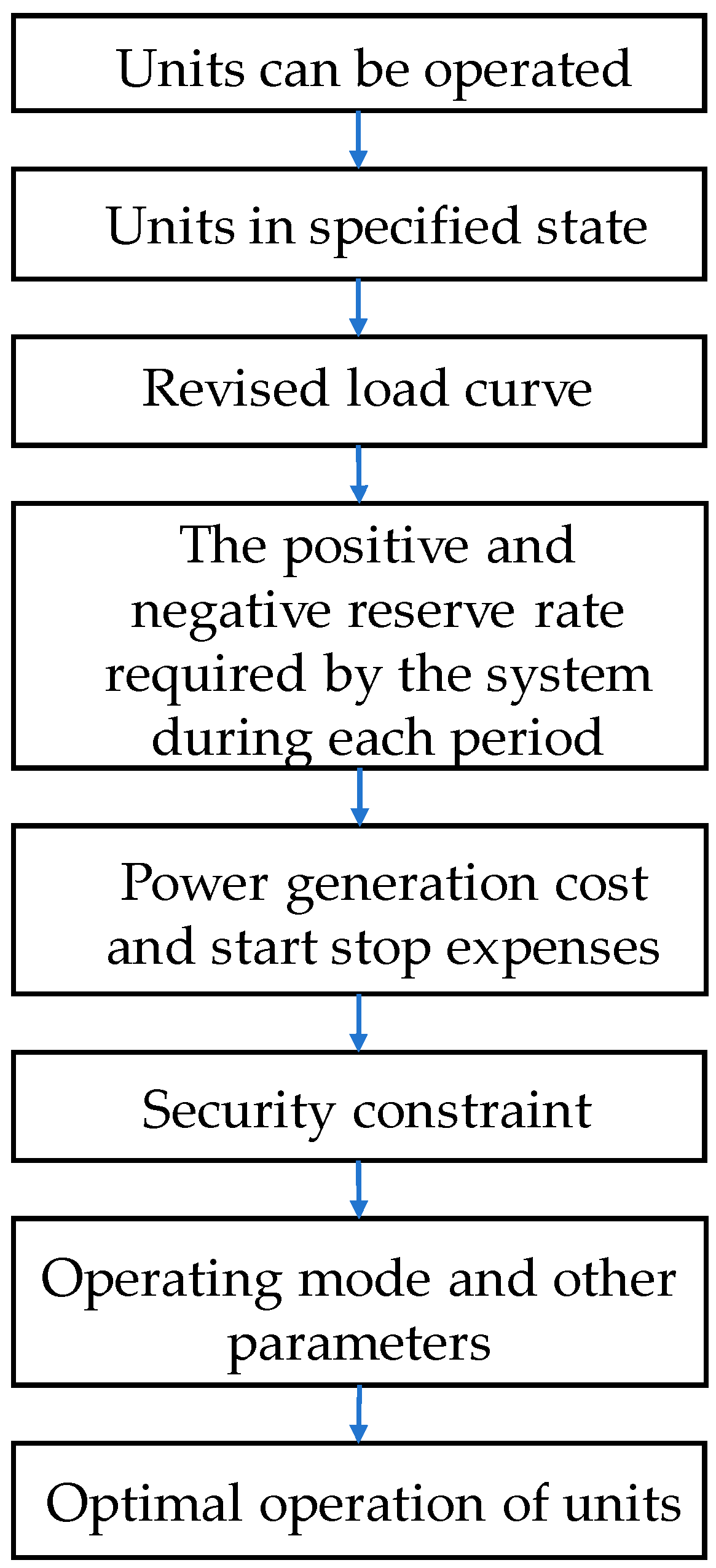


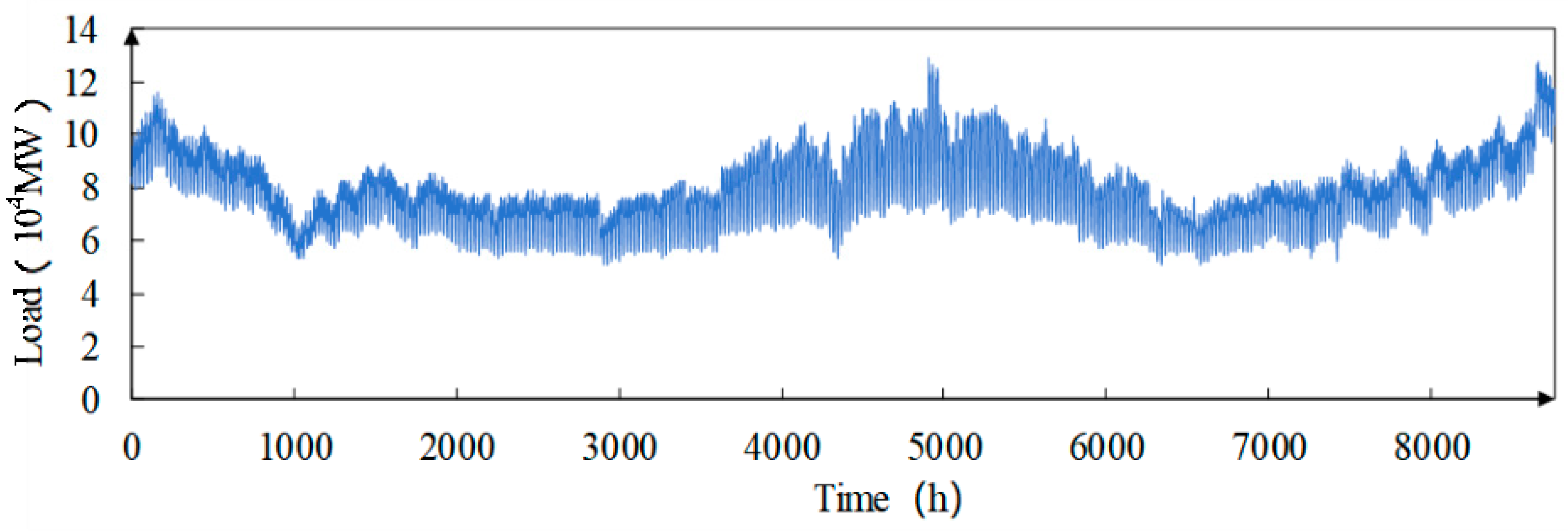
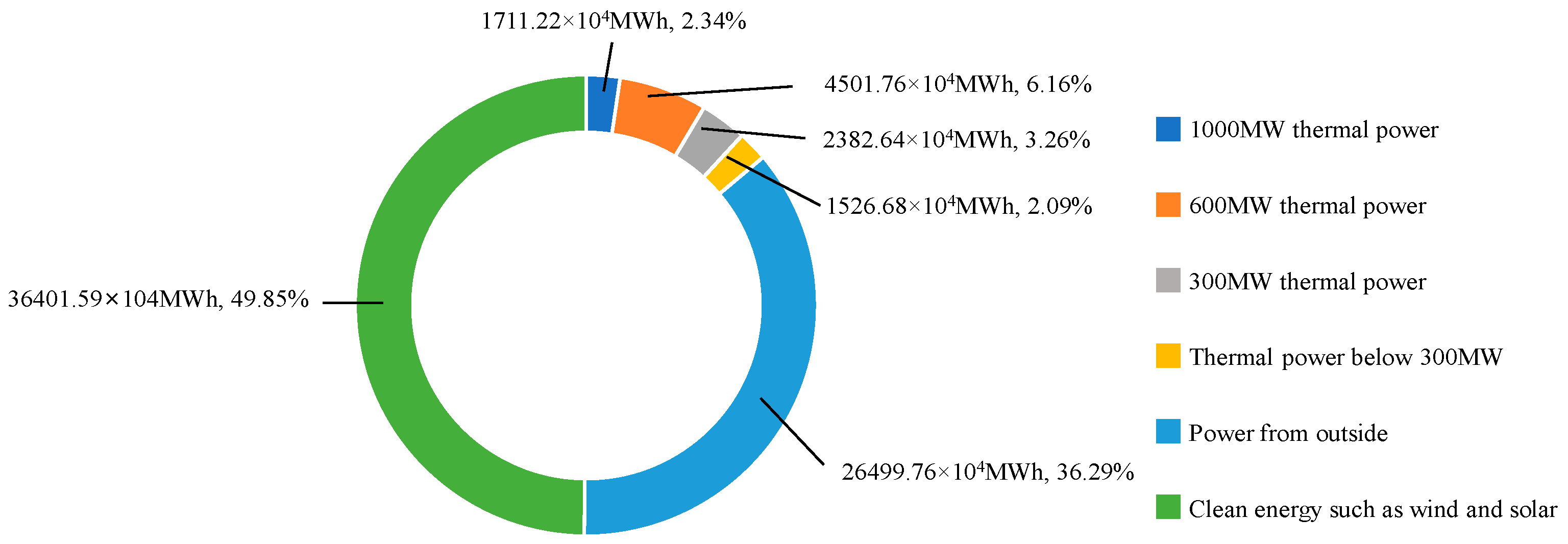

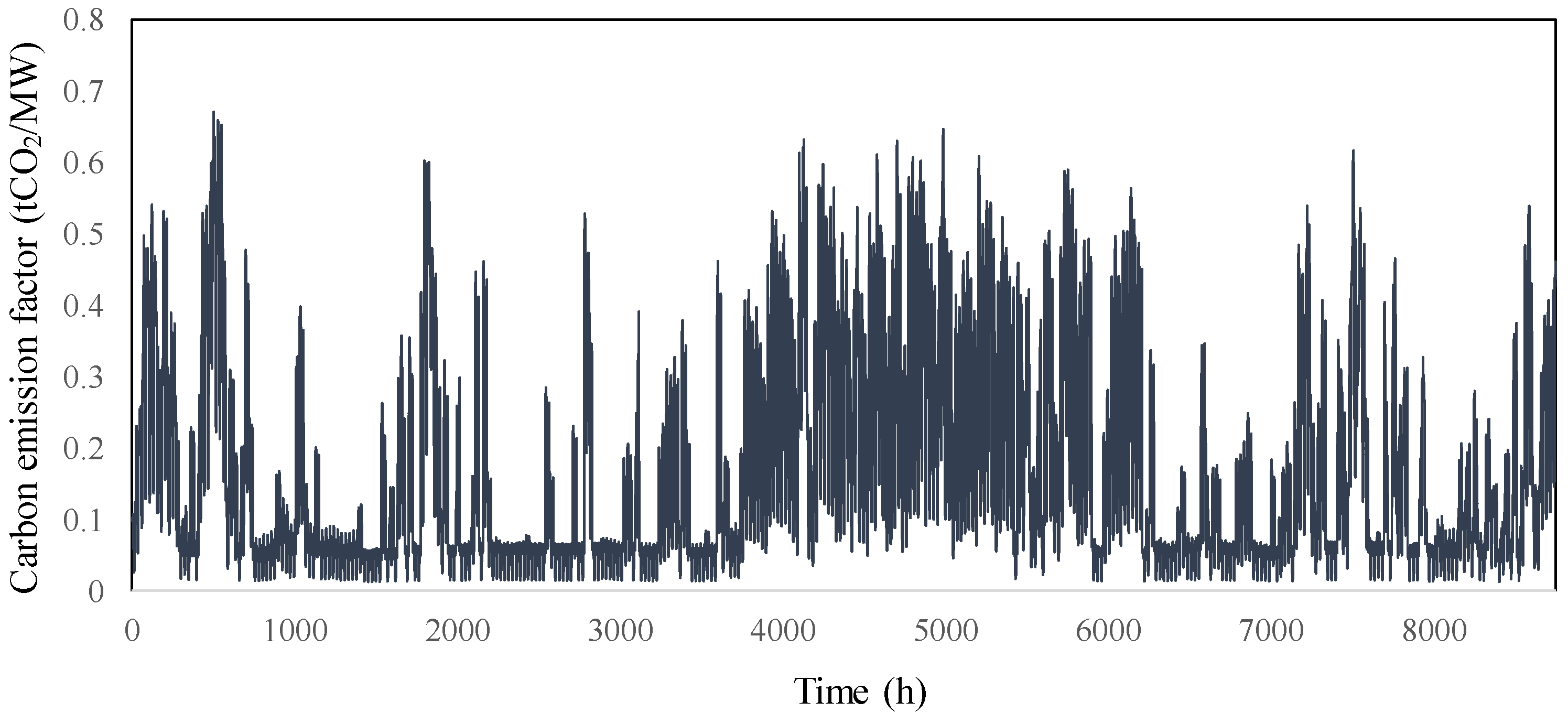

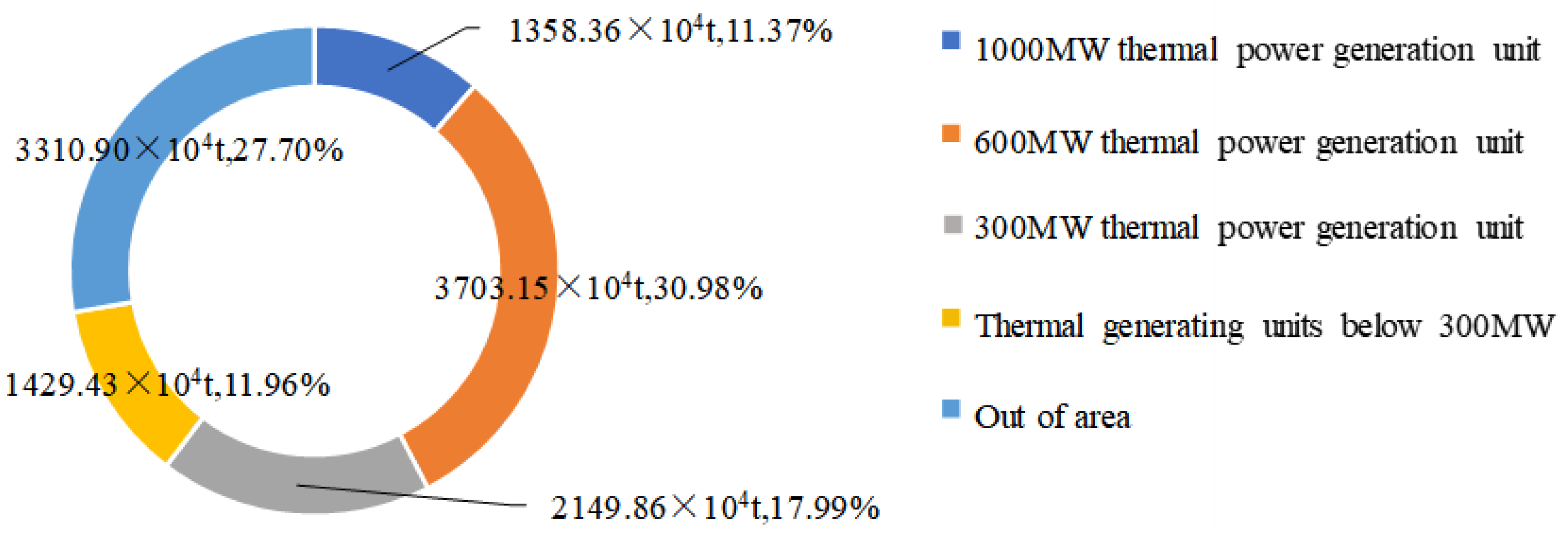
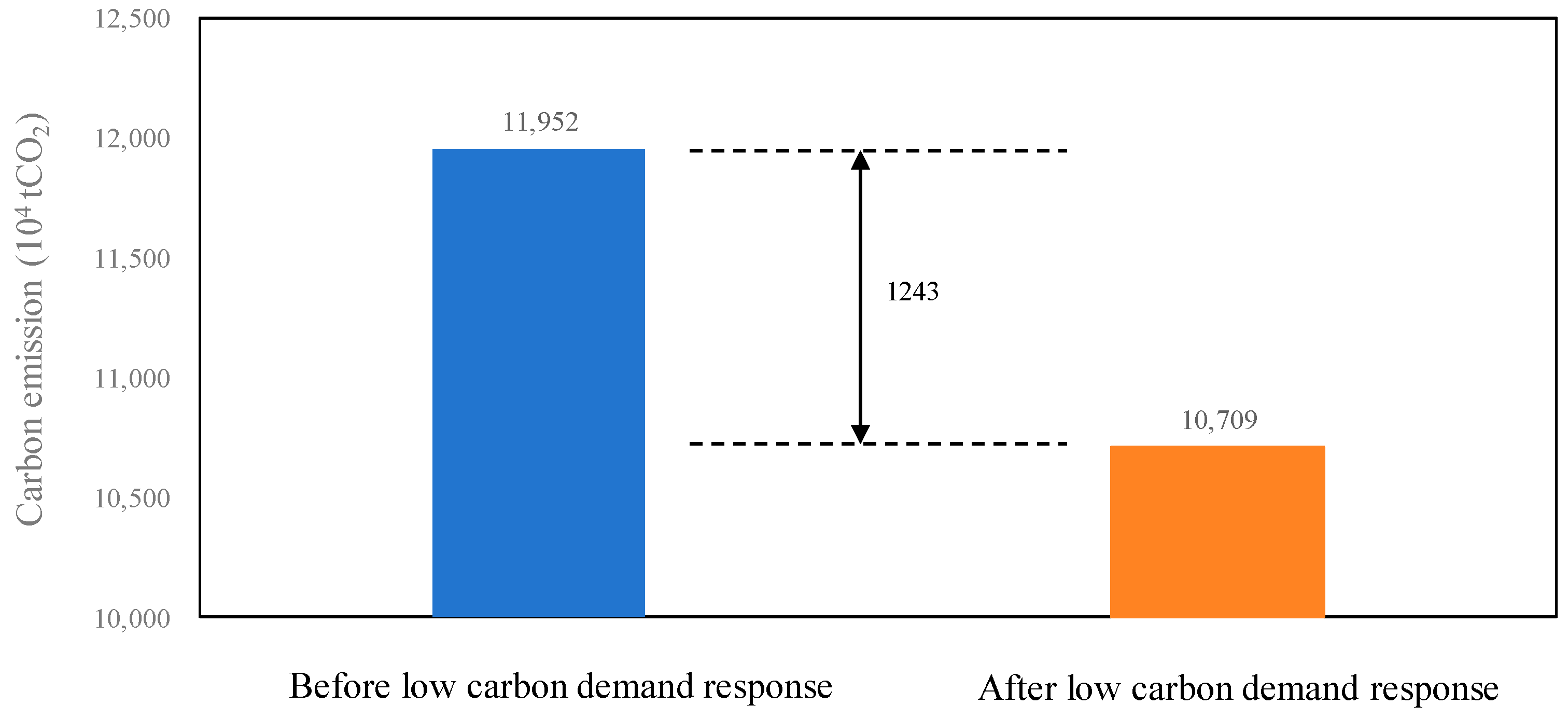

| Unit Type | Installed Capacity (MW) |
|---|---|
| Thermal power | 129,912 |
| Heating gas turbines | 39,178 |
| Wind power | 68,300 |
| Photovoltaic | 129,000 |
| Pumped storage | 90,470 |
| Other energy storage | 20,600 |
| Wind Region | Wind Power Installed Capacity (MW) |
|---|---|
| Wind region 1 | 17,758 |
| Wind region 2 | 50,542 |
| Photovoltaic Region | Photovoltaic Installed Capacity (MW) |
|---|---|
| Photovoltaic region 1 | 24,588 |
| Photovoltaic region 2 | 77,862 |
| Wind Power | Photovoltaic | Total | |
|---|---|---|---|
| Annual total power generation/104 MWh | 18,970.24 | 21,297.66 | 40,267.90 |
| Annual total power abandonment/104 MWh | 3033.18 | 833.13 | 3866.31 |
| Annual consumption rate% | 84.01 | 96.09 | 90.40 |
Disclaimer/Publisher’s Note: The statements, opinions and data contained in all publications are solely those of the individual author(s) and contributor(s) and not of MDPI and/or the editor(s). MDPI and/or the editor(s) disclaim responsibility for any injury to people or property resulting from any ideas, methods, instructions or products referred to in the content. |
© 2024 by the authors. Licensee MDPI, Basel, Switzerland. This article is an open access article distributed under the terms and conditions of the Creative Commons Attribution (CC BY) license (https://creativecommons.org/licenses/by/4.0/).
Share and Cite
Feng, H.; Ji, J.; Yang, C.; Li, F.; Li, Y.; Lyu, L. Analysis of Carbon Emission Reduction with Using Low-Carbon Demand Response: Case Study of North China Power Grid. Processes 2024, 12, 1324. https://doi.org/10.3390/pr12071324
Feng H, Ji J, Yang C, Li F, Li Y, Lyu L. Analysis of Carbon Emission Reduction with Using Low-Carbon Demand Response: Case Study of North China Power Grid. Processes. 2024; 12(7):1324. https://doi.org/10.3390/pr12071324
Chicago/Turabian StyleFeng, Haoran, Jie Ji, Chen Yang, Fuqiang Li, Yaowang Li, and Lanchun Lyu. 2024. "Analysis of Carbon Emission Reduction with Using Low-Carbon Demand Response: Case Study of North China Power Grid" Processes 12, no. 7: 1324. https://doi.org/10.3390/pr12071324





